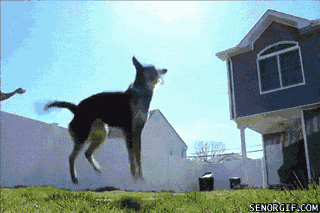
Pugs are so cool so why don't you have a look at some facts about them!
#1. "The Pug is a small, stocky, square, thickset dog."
#2. "The round head is massive with a short, blunt, square shaped muzzle."
#3. "Moles on the cheeks are considered beauty spots."
#4. "The teeth meet in a slight undershot bite."
#5. "The very large, prominent eyes are dark."
#6. "The small, thin ears are either rose or button shaped."
#7. "The face has large, deep wrinkles."
#8. "The high set tail is curled over the back and a double curl is preferred in the show ring."
#9. "The short coat is soft, fine and smooth. Coat colors come in apricot, fawn, black and silver."
#10. "The Pug is keen, with a happy-go-lucky attitude."
#11. "Animated, peppy and spirited, they are loyal, loving and affectionate with their families."
#12. "Playful, lively and rambunctious, they are sure to keep you laughing."
#13. "Highly intelligent, it bores easily without variety in their training."
#14. "They can be a bit willful if they sense they are stronger minded than the humans around them."
#15. "Pugs are sensitive to the tone of your voice, so harsh punishment is unnecessary."
#16. "They need an owner who is calm, yet firm, confident and consistent with the rules."
#17. "The dog is neither excitable nor dull."
#18. "They are good watchdogs, very devoted and are not yappers."
#19. "Pugs get along well with other dogs and pets, and they behave impeccably with both children and visitors."
#20. "Be sure to be your Pug's pack leader. Pugs who do not have strong human leaders can become jealous, and begin to display guarding behaviors, such as guarding furniture, food, toys, or other spots in the house. This behavior only happens when dogs are allowed to take over. These behaviors can be corrected when the owners start displaying the proper leadership."
#21. "Dogs who feel they need to run the home are not as happy as dogs who know they are human followers, as it is very stressful for a dog to need to keep "their" humans in line."
#22. "Height: Dogs 12-14 inches (30-36 cm.)
Bitches 10-12 inches (25-30 cm.)"
#23. "Weight: Dogs 13-20 pounds (6-9kg.)
Bitches 13-18 pounds (6-8kg.)"
#24. "Pugs catch colds easily and are stressed by hot and cold weather. They are prone to allergies and the short muzzle contributes to chronic breathing problems, tending to wheeze and snore. (Pugs suffer from poor ventilation.) Prone to skin problems. Pone to Pug Dog Encephalitis (PDE), an inflammation of the brain that strikes adolescent Pugs usually between the ages of 2 and 3. The cause is unknown. They are not the easiest whelpers. Dams usually have to have cesarean sections due to the size of the pups heads. There is a chance of keratites (inflammation of the cornea) and ulcers on the cornea. Eyes are prone to weeping. Do not overfeed a Pug, as they will eat more than is good for them, quickly becoming obese and living much shorter lives."
#25. "The Pug is good for apartment life. It is relatively inactive indoors and will do okay without a yard. Cannot withstand hot or cold weather and should be kept indoors at a comfortable temperature."
#26. "Pugs are strong dogs with short straight legs. They need to be taken on daily walks. While out on the walk the dog must be made to heel beside or behind the person holding the lead, as instinct tells a dog the leader leads the way, and that leader needs to be the human. They enjoy energetic games and will keep in better health if given regular exercise. But be careful not to over do it, especially if you see them start to wheeze."
#27. "Life Expectancy: About 12 to 15 years."
#28. "The smooth, short-haired coat is easy to groom. Brush and comb with a firm bristle brush and shampoo only when necessary. Dry thoroughly after a bath so the dog does not get chilled. The creases on the face must be cleaned regularly. This breed is a seasonally heavy shedder."
Info from: http://www.dogbreedinfo.com/pug.htm
Pic from: http://www.puppyparadise.com/pug_breed_info.html













